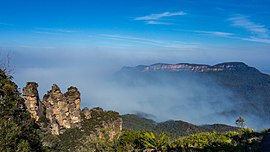| Blue Mountains National Park New South Wales | |
|---|---|
 | |
| Nearest town or city | Katoomba |
| Coordinates | 33°37′S 150°28′E / 33.62°S 150.46°E |
| Population | 0 (SAL 2016)[1][2] |
| Established | September 1959[3] |
| Area | 2,679.54 km2 (1,034.6 sq mi)[3] |
| Visitation | 8,438,671[4] (in 2018)[5] |
| Managing authorities | NSW National Parks & Wildlife Service |
| Website | Blue Mountains National Park |
| See also | Protected areas of New South Wales |
The Blue Mountains National Park is a protected national park that is located in the Blue Mountains region of New South Wales, in eastern Australia. The 267,954-hectare (662,130-acre) national park is situated approximately 80 kilometres (50 mi) west of the Sydney CBD, and the park boundary is quite irregular as it is broken up by roads, urban areas and areas of private property.[3] Despite the name mountains, the area is an uplifted plateau, dissected by a number of larger rivers. The highest point in the park is Mount Werong at 1,215 metres (3,986 ft) above sea level; while the low point is on the Nepean River at 20 metres (66 ft) above sea level as it leaves the park.[6]
The national park is one of the eight protected areas that, in 2000, was inscribed to form part of the UNESCO World Heritage–listed Greater Blue Mountains Area.[7] The Greater Blue Mountains was one of 15 World Heritage places included in the National Heritage List on 21 May 2007.[8] The Blue Mountains National Park is the most central of the eight protected areas within the World Heritage Site and it forms part of the Great Dividing Range. The park is also listed on the Australian Heritage Register and the overall complex of Blue Mountains regional walking tracks is listed on the State Heritage Register.[9]
Cite error: There are <ref group=lower-alpha> tags or {{efn}} templates on this page, but the references will not show without a {{reflist|group=lower-alpha}} template or {{notelist}} template (see the help page).
- ^ Australian Bureau of Statistics (27 June 2017). "Blue Mountains National Park (suburb and locality)". Australian Census 2016.
- ^ Australian Bureau of Statistics (27 June 2017). "Blue Mountains National Park (suburb and locality)". Australian Census 2016 QuickStats. Retrieved 28 June 2022.
- ^ a b c "Blue Mountains National Park: Park management". Office of Environment & Heritage. Government of New South Wales. Retrieved 8 October 2014.
- ^ "Domestic visitation". NSW Environment, Energy and Science. Retrieved 29 March 2022.
- ^ Cite error: The named reference
awcvtwas invoked but never defined (see the help page). - ^ "Blue Mountains Facts - Blue Mountains Australia Guide". bluemountains-australia.com. Retrieved 8 April 2018.
- ^ "Greater Blue Mountains Area". World Heritage List. UNESCO. 2014. Retrieved 31 August 2014.
- ^ "World Heritage Places - Greater Blue Mountains". Australian Government Department of the Environment and Energy.
- ^ "Blue Mountains Walking tracks". NSW State Heritage Register. Government of New South Wales. 2 April 1999. Retrieved 8 October 2014.

